Accounting Report: Analyzing Business Structures and Governance
VerifiedAdded on 2020/06/03
|10
|2661
|240
Report
AI Summary
This accounting report delves into various business structures, commencing with an introduction to accounting's role in achieving sustainable advantages. It examines the suitability of sole proprietorship for new ventures, detailing its advantages like profit retention and low registration costs, alongside disadvantages such as limited funds and liability. The report then explores stakeholders, classifying them into internal and external groups like customers, government, investors, and creditors, emphasizing the importance of transparency and corporate responsibility. A memorandum addresses key issues arising from strikes and environmental concerns, proposing solutions involving management accounting tools and compliance with environmental laws. Part B analyzes partnership factors, joint liability, and partner liabilities, differentiating between public and proprietary companies, and discussing the concept of a separate legal entity. The report offers a comprehensive overview of accounting concepts, business structures, and corporate governance.

ACCOUNTING
Paraphrase This Document
Need a fresh take? Get an instant paraphrase of this document with our AI Paraphraser
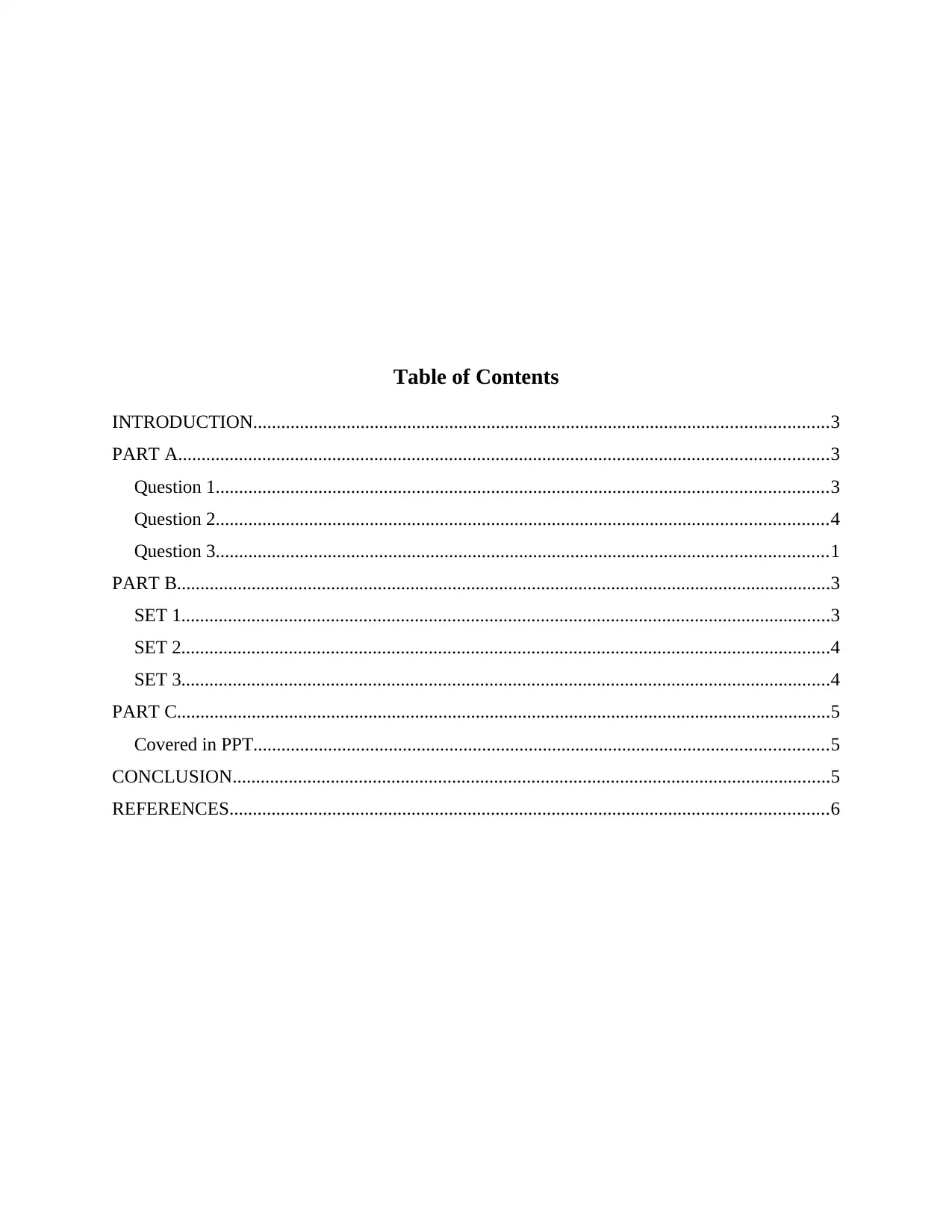
Table of Contents
INTRODUCTION...........................................................................................................................3
PART A...........................................................................................................................................3
Question 1...................................................................................................................................3
Question 2...................................................................................................................................4
Question 3...................................................................................................................................1
PART B............................................................................................................................................3
SET 1...........................................................................................................................................3
SET 2...........................................................................................................................................4
SET 3...........................................................................................................................................4
PART C............................................................................................................................................5
Covered in PPT...........................................................................................................................5
CONCLUSION................................................................................................................................5
REFERENCES................................................................................................................................6
INTRODUCTION...........................................................................................................................3
PART A...........................................................................................................................................3
Question 1...................................................................................................................................3
Question 2...................................................................................................................................4
Question 3...................................................................................................................................1
PART B............................................................................................................................................3
SET 1...........................................................................................................................................3
SET 2...........................................................................................................................................4
SET 3...........................................................................................................................................4
PART C............................................................................................................................................5
Covered in PPT...........................................................................................................................5
CONCLUSION................................................................................................................................5
REFERENCES................................................................................................................................6
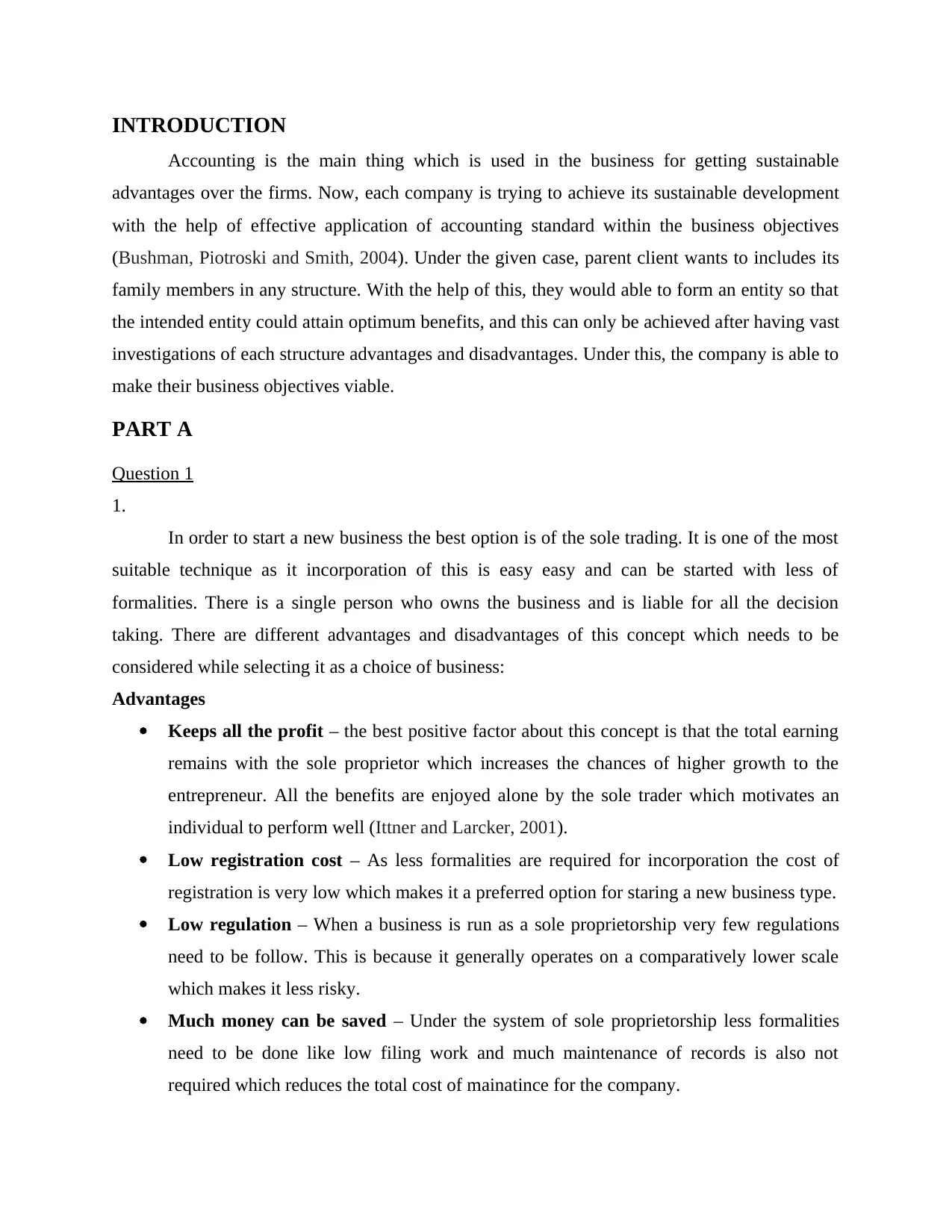
INTRODUCTION
Accounting is the main thing which is used in the business for getting sustainable
advantages over the firms. Now, each company is trying to achieve its sustainable development
with the help of effective application of accounting standard within the business objectives
(Bushman, Piotroski and Smith, 2004). Under the given case, parent client wants to includes its
family members in any structure. With the help of this, they would able to form an entity so that
the intended entity could attain optimum benefits, and this can only be achieved after having vast
investigations of each structure advantages and disadvantages. Under this, the company is able to
make their business objectives viable.
PART A
Question 1
1.
In order to start a new business the best option is of the sole trading. It is one of the most
suitable technique as it incorporation of this is easy easy and can be started with less of
formalities. There is a single person who owns the business and is liable for all the decision
taking. There are different advantages and disadvantages of this concept which needs to be
considered while selecting it as a choice of business:
Advantages
Keeps all the profit – the best positive factor about this concept is that the total earning
remains with the sole proprietor which increases the chances of higher growth to the
entrepreneur. All the benefits are enjoyed alone by the sole trader which motivates an
individual to perform well (Ittner and Larcker, 2001).
Low registration cost – As less formalities are required for incorporation the cost of
registration is very low which makes it a preferred option for staring a new business type.
Low regulation – When a business is run as a sole proprietorship very few regulations
need to be follow. This is because it generally operates on a comparatively lower scale
which makes it less risky.
Much money can be saved – Under the system of sole proprietorship less formalities
need to be done like low filing work and much maintenance of records is also not
required which reduces the total cost of mainatince for the company.
Accounting is the main thing which is used in the business for getting sustainable
advantages over the firms. Now, each company is trying to achieve its sustainable development
with the help of effective application of accounting standard within the business objectives
(Bushman, Piotroski and Smith, 2004). Under the given case, parent client wants to includes its
family members in any structure. With the help of this, they would able to form an entity so that
the intended entity could attain optimum benefits, and this can only be achieved after having vast
investigations of each structure advantages and disadvantages. Under this, the company is able to
make their business objectives viable.
PART A
Question 1
1.
In order to start a new business the best option is of the sole trading. It is one of the most
suitable technique as it incorporation of this is easy easy and can be started with less of
formalities. There is a single person who owns the business and is liable for all the decision
taking. There are different advantages and disadvantages of this concept which needs to be
considered while selecting it as a choice of business:
Advantages
Keeps all the profit – the best positive factor about this concept is that the total earning
remains with the sole proprietor which increases the chances of higher growth to the
entrepreneur. All the benefits are enjoyed alone by the sole trader which motivates an
individual to perform well (Ittner and Larcker, 2001).
Low registration cost – As less formalities are required for incorporation the cost of
registration is very low which makes it a preferred option for staring a new business type.
Low regulation – When a business is run as a sole proprietorship very few regulations
need to be follow. This is because it generally operates on a comparatively lower scale
which makes it less risky.
Much money can be saved – Under the system of sole proprietorship less formalities
need to be done like low filing work and much maintenance of records is also not
required which reduces the total cost of mainatince for the company.
⊘ This is a preview!⊘
Do you want full access?
Subscribe today to unlock all pages.

Trusted by 1+ million students worldwide
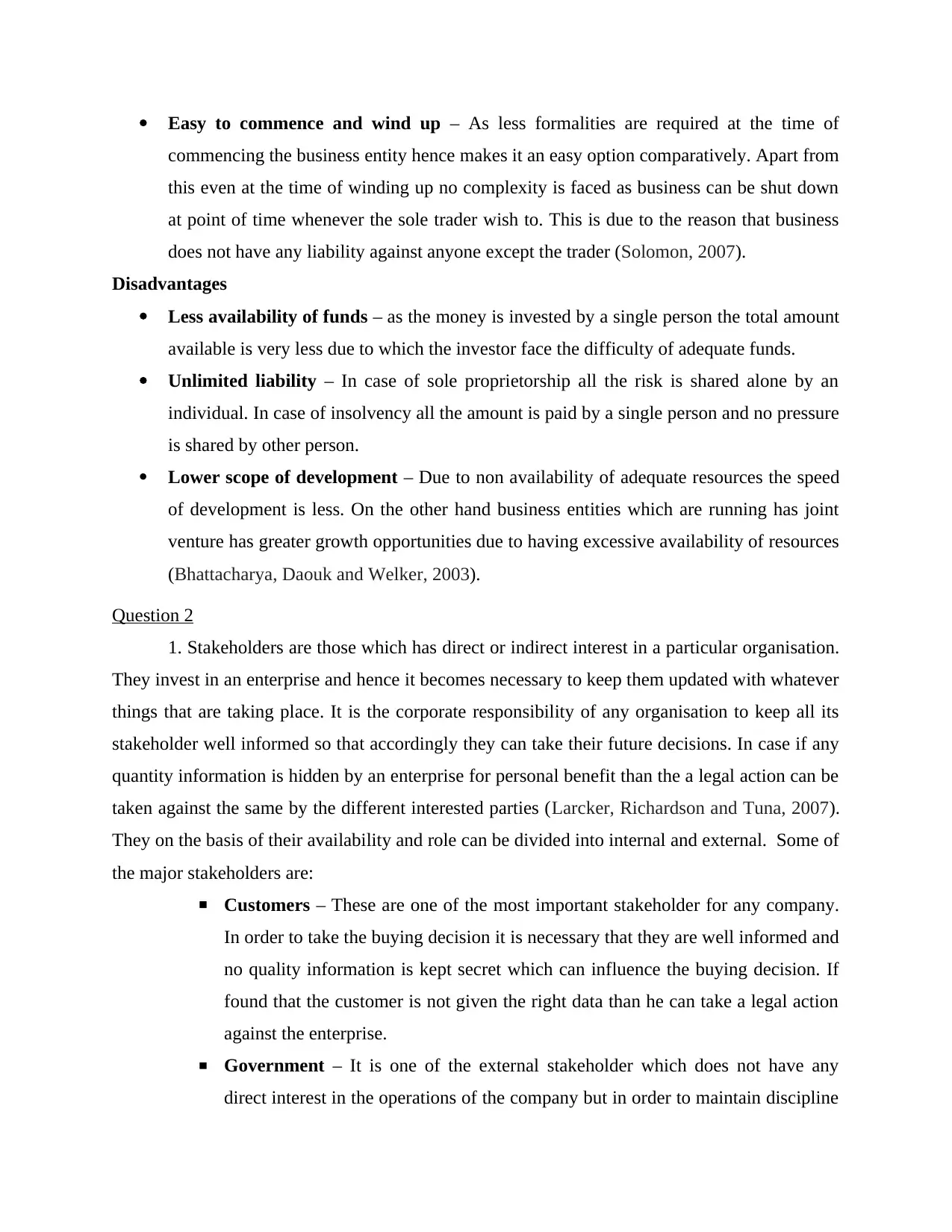
Easy to commence and wind up – As less formalities are required at the time of
commencing the business entity hence makes it an easy option comparatively. Apart from
this even at the time of winding up no complexity is faced as business can be shut down
at point of time whenever the sole trader wish to. This is due to the reason that business
does not have any liability against anyone except the trader (Solomon, 2007).
Disadvantages
Less availability of funds – as the money is invested by a single person the total amount
available is very less due to which the investor face the difficulty of adequate funds.
Unlimited liability – In case of sole proprietorship all the risk is shared alone by an
individual. In case of insolvency all the amount is paid by a single person and no pressure
is shared by other person.
Lower scope of development – Due to non availability of adequate resources the speed
of development is less. On the other hand business entities which are running has joint
venture has greater growth opportunities due to having excessive availability of resources
(Bhattacharya, Daouk and Welker, 2003).
Question 2
1. Stakeholders are those which has direct or indirect interest in a particular organisation.
They invest in an enterprise and hence it becomes necessary to keep them updated with whatever
things that are taking place. It is the corporate responsibility of any organisation to keep all its
stakeholder well informed so that accordingly they can take their future decisions. In case if any
quantity information is hidden by an enterprise for personal benefit than the a legal action can be
taken against the same by the different interested parties (Larcker, Richardson and Tuna, 2007).
They on the basis of their availability and role can be divided into internal and external. Some of
the major stakeholders are:
▪ Customers – These are one of the most important stakeholder for any company.
In order to take the buying decision it is necessary that they are well informed and
no quality information is kept secret which can influence the buying decision. If
found that the customer is not given the right data than he can take a legal action
against the enterprise.
▪ Government – It is one of the external stakeholder which does not have any
direct interest in the operations of the company but in order to maintain discipline
commencing the business entity hence makes it an easy option comparatively. Apart from
this even at the time of winding up no complexity is faced as business can be shut down
at point of time whenever the sole trader wish to. This is due to the reason that business
does not have any liability against anyone except the trader (Solomon, 2007).
Disadvantages
Less availability of funds – as the money is invested by a single person the total amount
available is very less due to which the investor face the difficulty of adequate funds.
Unlimited liability – In case of sole proprietorship all the risk is shared alone by an
individual. In case of insolvency all the amount is paid by a single person and no pressure
is shared by other person.
Lower scope of development – Due to non availability of adequate resources the speed
of development is less. On the other hand business entities which are running has joint
venture has greater growth opportunities due to having excessive availability of resources
(Bhattacharya, Daouk and Welker, 2003).
Question 2
1. Stakeholders are those which has direct or indirect interest in a particular organisation.
They invest in an enterprise and hence it becomes necessary to keep them updated with whatever
things that are taking place. It is the corporate responsibility of any organisation to keep all its
stakeholder well informed so that accordingly they can take their future decisions. In case if any
quantity information is hidden by an enterprise for personal benefit than the a legal action can be
taken against the same by the different interested parties (Larcker, Richardson and Tuna, 2007).
They on the basis of their availability and role can be divided into internal and external. Some of
the major stakeholders are:
▪ Customers – These are one of the most important stakeholder for any company.
In order to take the buying decision it is necessary that they are well informed and
no quality information is kept secret which can influence the buying decision. If
found that the customer is not given the right data than he can take a legal action
against the enterprise.
▪ Government – It is one of the external stakeholder which does not have any
direct interest in the operations of the company but in order to maintain discipline
Paraphrase This Document
Need a fresh take? Get an instant paraphrase of this document with our AI Paraphraser
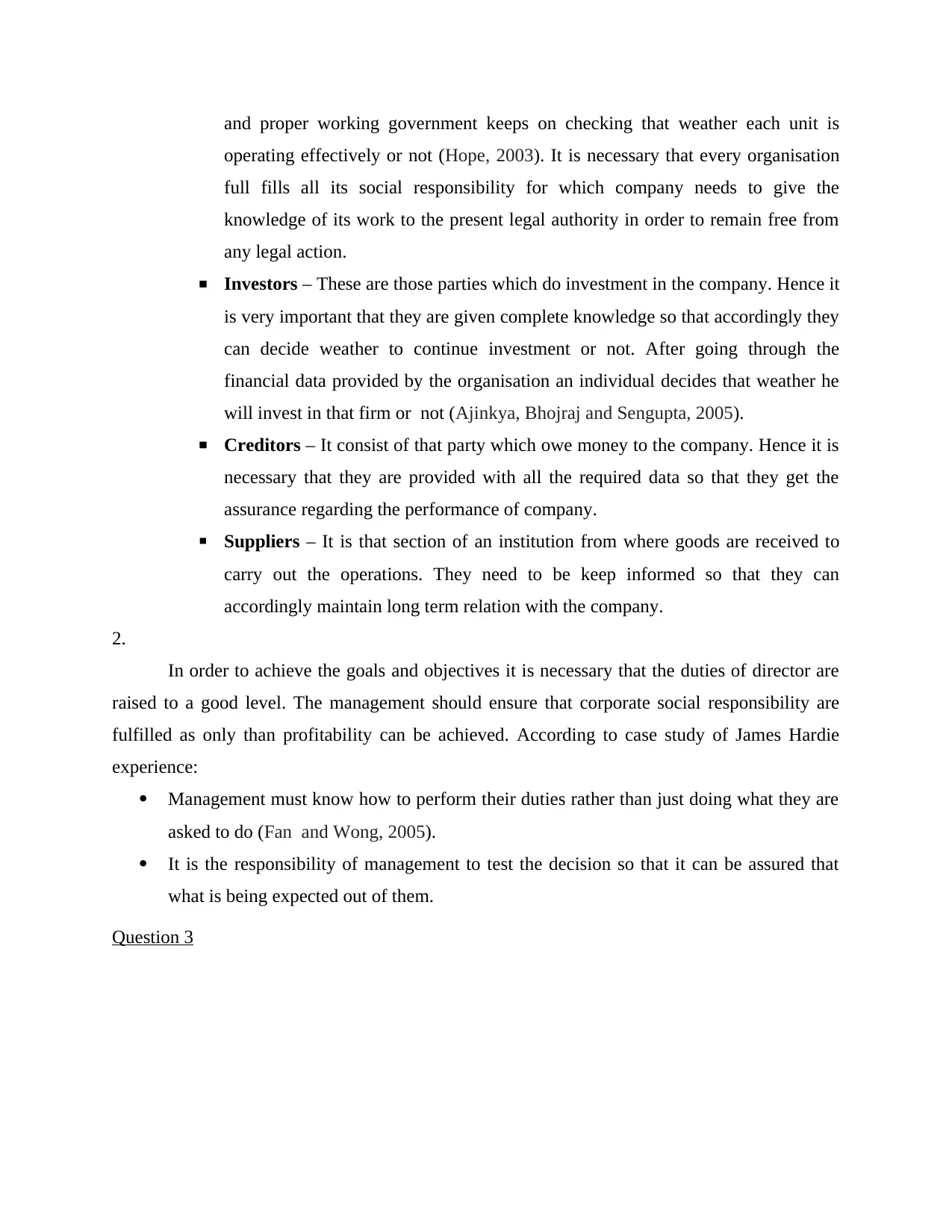
and proper working government keeps on checking that weather each unit is
operating effectively or not (Hope, 2003). It is necessary that every organisation
full fills all its social responsibility for which company needs to give the
knowledge of its work to the present legal authority in order to remain free from
any legal action.
▪ Investors – These are those parties which do investment in the company. Hence it
is very important that they are given complete knowledge so that accordingly they
can decide weather to continue investment or not. After going through the
financial data provided by the organisation an individual decides that weather he
will invest in that firm or not (Ajinkya, Bhojraj and Sengupta, 2005).
▪ Creditors – It consist of that party which owe money to the company. Hence it is
necessary that they are provided with all the required data so that they get the
assurance regarding the performance of company.
▪ Suppliers – It is that section of an institution from where goods are received to
carry out the operations. They need to be keep informed so that they can
accordingly maintain long term relation with the company.
2.
In order to achieve the goals and objectives it is necessary that the duties of director are
raised to a good level. The management should ensure that corporate social responsibility are
fulfilled as only than profitability can be achieved. According to case study of James Hardie
experience:
Management must know how to perform their duties rather than just doing what they are
asked to do (Fan and Wong, 2005).
It is the responsibility of management to test the decision so that it can be assured that
what is being expected out of them.
Question 3
operating effectively or not (Hope, 2003). It is necessary that every organisation
full fills all its social responsibility for which company needs to give the
knowledge of its work to the present legal authority in order to remain free from
any legal action.
▪ Investors – These are those parties which do investment in the company. Hence it
is very important that they are given complete knowledge so that accordingly they
can decide weather to continue investment or not. After going through the
financial data provided by the organisation an individual decides that weather he
will invest in that firm or not (Ajinkya, Bhojraj and Sengupta, 2005).
▪ Creditors – It consist of that party which owe money to the company. Hence it is
necessary that they are provided with all the required data so that they get the
assurance regarding the performance of company.
▪ Suppliers – It is that section of an institution from where goods are received to
carry out the operations. They need to be keep informed so that they can
accordingly maintain long term relation with the company.
2.
In order to achieve the goals and objectives it is necessary that the duties of director are
raised to a good level. The management should ensure that corporate social responsibility are
fulfilled as only than profitability can be achieved. According to case study of James Hardie
experience:
Management must know how to perform their duties rather than just doing what they are
asked to do (Fan and Wong, 2005).
It is the responsibility of management to test the decision so that it can be assured that
what is being expected out of them.
Question 3
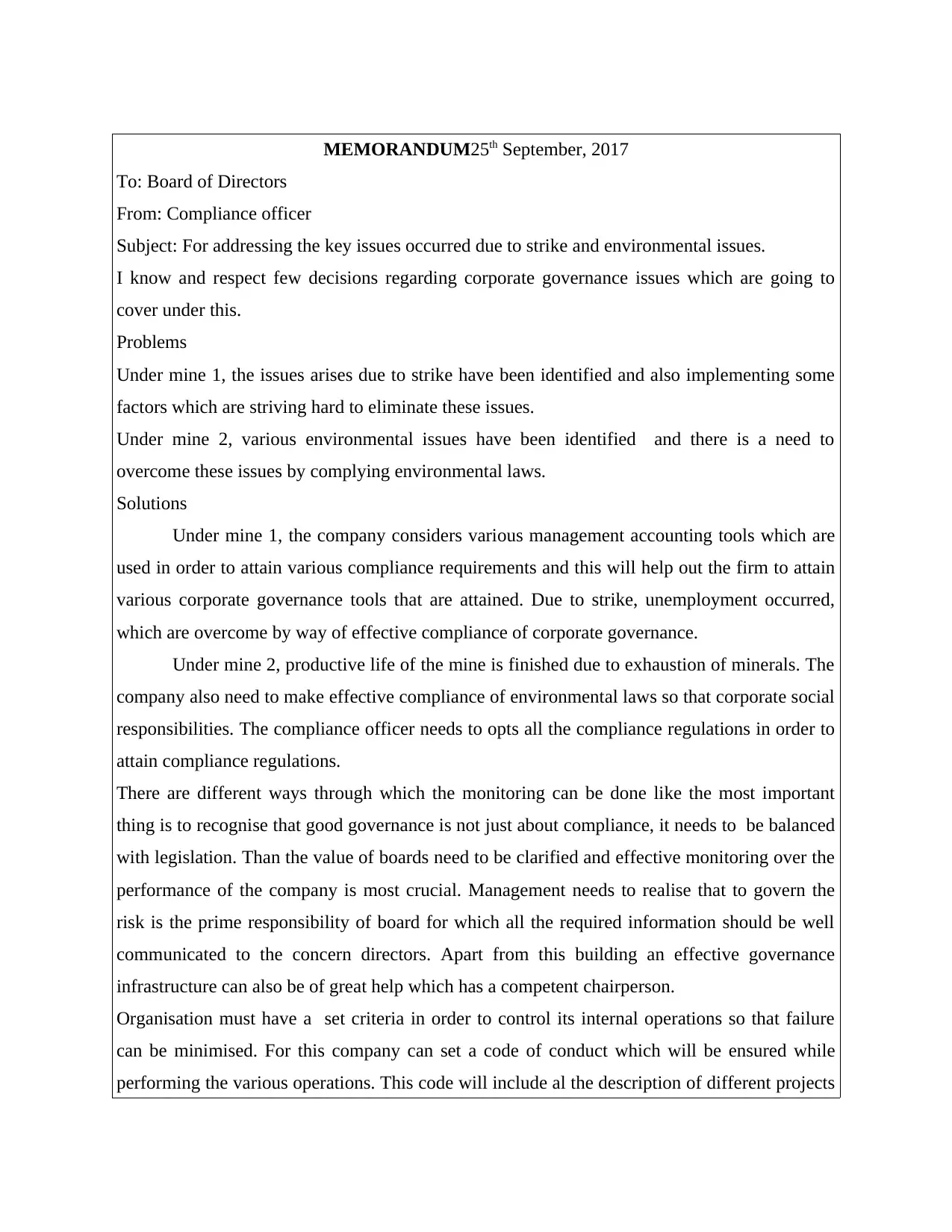
MEMORANDUM25th September, 2017
To: Board of Directors
From: Compliance officer
Subject: For addressing the key issues occurred due to strike and environmental issues.
I know and respect few decisions regarding corporate governance issues which are going to
cover under this.
Problems
Under mine 1, the issues arises due to strike have been identified and also implementing some
factors which are striving hard to eliminate these issues.
Under mine 2, various environmental issues have been identified and there is a need to
overcome these issues by complying environmental laws.
Solutions
Under mine 1, the company considers various management accounting tools which are
used in order to attain various compliance requirements and this will help out the firm to attain
various corporate governance tools that are attained. Due to strike, unemployment occurred,
which are overcome by way of effective compliance of corporate governance.
Under mine 2, productive life of the mine is finished due to exhaustion of minerals. The
company also need to make effective compliance of environmental laws so that corporate social
responsibilities. The compliance officer needs to opts all the compliance regulations in order to
attain compliance regulations.
There are different ways through which the monitoring can be done like the most important
thing is to recognise that good governance is not just about compliance, it needs to be balanced
with legislation. Than the value of boards need to be clarified and effective monitoring over the
performance of the company is most crucial. Management needs to realise that to govern the
risk is the prime responsibility of board for which all the required information should be well
communicated to the concern directors. Apart from this building an effective governance
infrastructure can also be of great help which has a competent chairperson.
Organisation must have a set criteria in order to control its internal operations so that failure
can be minimised. For this company can set a code of conduct which will be ensured while
performing the various operations. This code will include al the description of different projects
To: Board of Directors
From: Compliance officer
Subject: For addressing the key issues occurred due to strike and environmental issues.
I know and respect few decisions regarding corporate governance issues which are going to
cover under this.
Problems
Under mine 1, the issues arises due to strike have been identified and also implementing some
factors which are striving hard to eliminate these issues.
Under mine 2, various environmental issues have been identified and there is a need to
overcome these issues by complying environmental laws.
Solutions
Under mine 1, the company considers various management accounting tools which are
used in order to attain various compliance requirements and this will help out the firm to attain
various corporate governance tools that are attained. Due to strike, unemployment occurred,
which are overcome by way of effective compliance of corporate governance.
Under mine 2, productive life of the mine is finished due to exhaustion of minerals. The
company also need to make effective compliance of environmental laws so that corporate social
responsibilities. The compliance officer needs to opts all the compliance regulations in order to
attain compliance regulations.
There are different ways through which the monitoring can be done like the most important
thing is to recognise that good governance is not just about compliance, it needs to be balanced
with legislation. Than the value of boards need to be clarified and effective monitoring over the
performance of the company is most crucial. Management needs to realise that to govern the
risk is the prime responsibility of board for which all the required information should be well
communicated to the concern directors. Apart from this building an effective governance
infrastructure can also be of great help which has a competent chairperson.
Organisation must have a set criteria in order to control its internal operations so that failure
can be minimised. For this company can set a code of conduct which will be ensured while
performing the various operations. This code will include al the description of different projects
⊘ This is a preview!⊘
Do you want full access?
Subscribe today to unlock all pages.

Trusted by 1+ million students worldwide
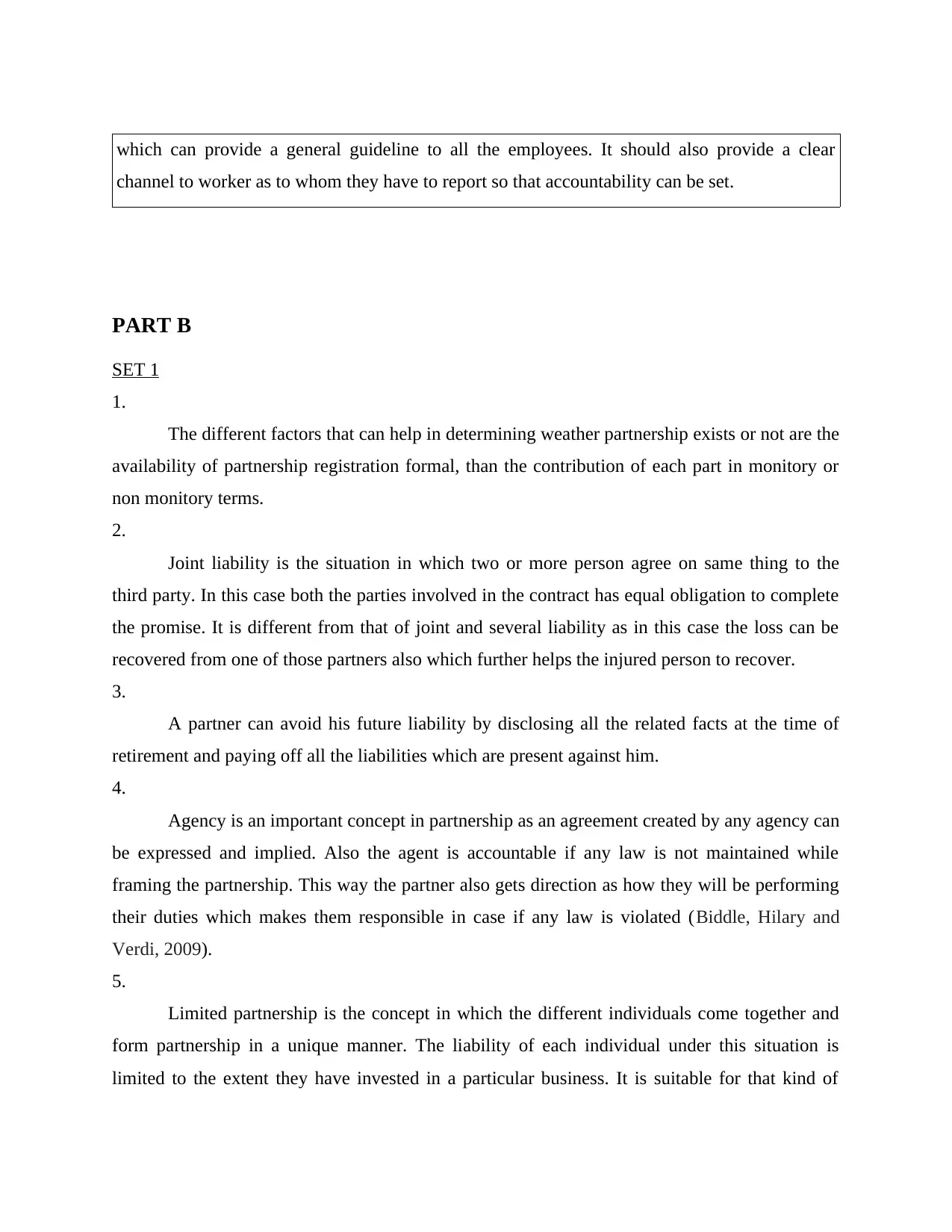
which can provide a general guideline to all the employees. It should also provide a clear
channel to worker as to whom they have to report so that accountability can be set.
PART B
SET 1
1.
The different factors that can help in determining weather partnership exists or not are the
availability of partnership registration formal, than the contribution of each part in monitory or
non monitory terms.
2.
Joint liability is the situation in which two or more person agree on same thing to the
third party. In this case both the parties involved in the contract has equal obligation to complete
the promise. It is different from that of joint and several liability as in this case the loss can be
recovered from one of those partners also which further helps the injured person to recover.
3.
A partner can avoid his future liability by disclosing all the related facts at the time of
retirement and paying off all the liabilities which are present against him.
4.
Agency is an important concept in partnership as an agreement created by any agency can
be expressed and implied. Also the agent is accountable if any law is not maintained while
framing the partnership. This way the partner also gets direction as how they will be performing
their duties which makes them responsible in case if any law is violated (Biddle, Hilary and
Verdi, 2009).
5.
Limited partnership is the concept in which the different individuals come together and
form partnership in a unique manner. The liability of each individual under this situation is
limited to the extent they have invested in a particular business. It is suitable for that kind of
channel to worker as to whom they have to report so that accountability can be set.
PART B
SET 1
1.
The different factors that can help in determining weather partnership exists or not are the
availability of partnership registration formal, than the contribution of each part in monitory or
non monitory terms.
2.
Joint liability is the situation in which two or more person agree on same thing to the
third party. In this case both the parties involved in the contract has equal obligation to complete
the promise. It is different from that of joint and several liability as in this case the loss can be
recovered from one of those partners also which further helps the injured person to recover.
3.
A partner can avoid his future liability by disclosing all the related facts at the time of
retirement and paying off all the liabilities which are present against him.
4.
Agency is an important concept in partnership as an agreement created by any agency can
be expressed and implied. Also the agent is accountable if any law is not maintained while
framing the partnership. This way the partner also gets direction as how they will be performing
their duties which makes them responsible in case if any law is violated (Biddle, Hilary and
Verdi, 2009).
5.
Limited partnership is the concept in which the different individuals come together and
form partnership in a unique manner. The liability of each individual under this situation is
limited to the extent they have invested in a particular business. It is suitable for that kind of
Paraphrase This Document
Need a fresh take? Get an instant paraphrase of this document with our AI Paraphraser
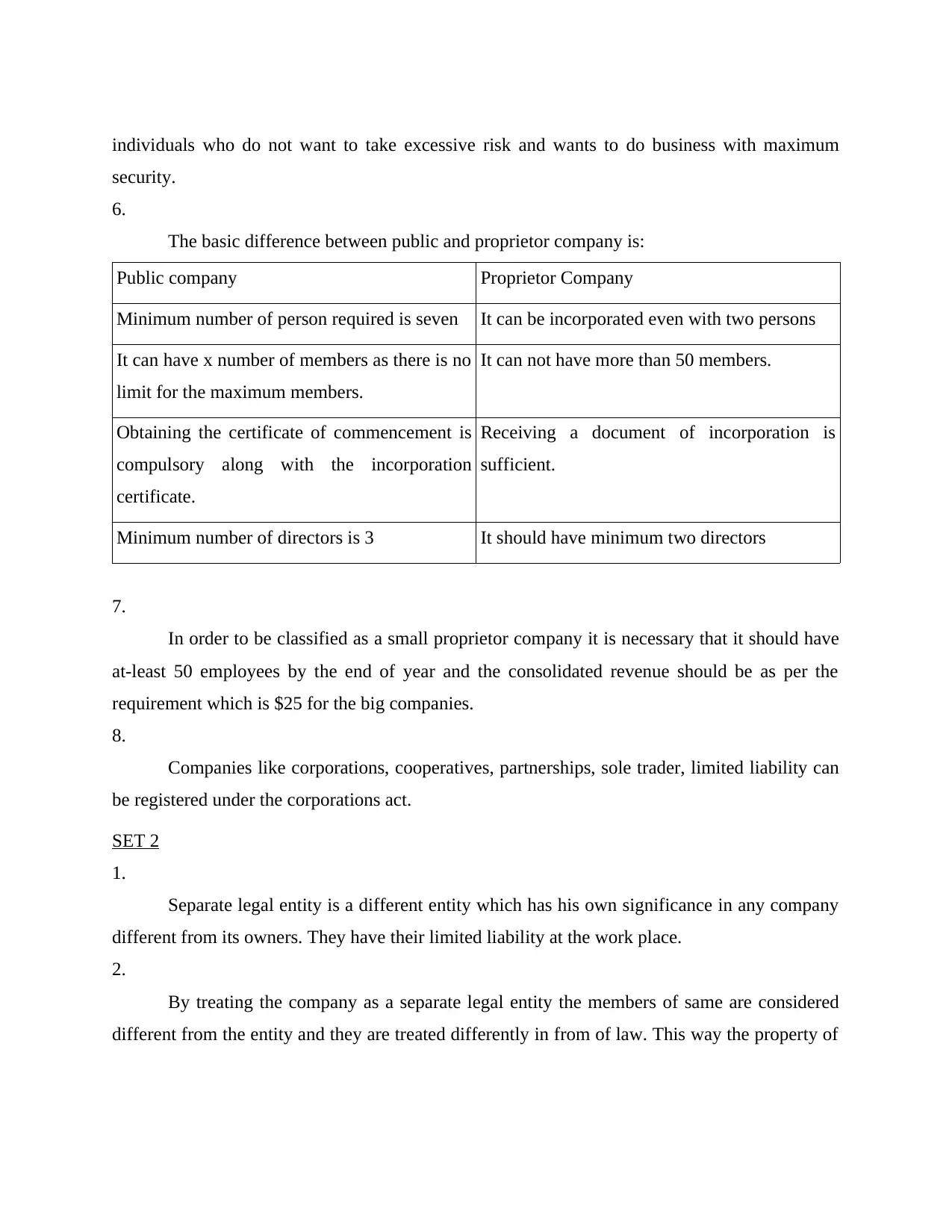
individuals who do not want to take excessive risk and wants to do business with maximum
security.
6.
The basic difference between public and proprietor company is:
Public company Proprietor Company
Minimum number of person required is seven It can be incorporated even with two persons
It can have x number of members as there is no
limit for the maximum members.
It can not have more than 50 members.
Obtaining the certificate of commencement is
compulsory along with the incorporation
certificate.
Receiving a document of incorporation is
sufficient.
Minimum number of directors is 3 It should have minimum two directors
7.
In order to be classified as a small proprietor company it is necessary that it should have
at-least 50 employees by the end of year and the consolidated revenue should be as per the
requirement which is $25 for the big companies.
8.
Companies like corporations, cooperatives, partnerships, sole trader, limited liability can
be registered under the corporations act.
SET 2
1.
Separate legal entity is a different entity which has his own significance in any company
different from its owners. They have their limited liability at the work place.
2.
By treating the company as a separate legal entity the members of same are considered
different from the entity and they are treated differently in from of law. This way the property of
security.
6.
The basic difference between public and proprietor company is:
Public company Proprietor Company
Minimum number of person required is seven It can be incorporated even with two persons
It can have x number of members as there is no
limit for the maximum members.
It can not have more than 50 members.
Obtaining the certificate of commencement is
compulsory along with the incorporation
certificate.
Receiving a document of incorporation is
sufficient.
Minimum number of directors is 3 It should have minimum two directors
7.
In order to be classified as a small proprietor company it is necessary that it should have
at-least 50 employees by the end of year and the consolidated revenue should be as per the
requirement which is $25 for the big companies.
8.
Companies like corporations, cooperatives, partnerships, sole trader, limited liability can
be registered under the corporations act.
SET 2
1.
Separate legal entity is a different entity which has his own significance in any company
different from its owners. They have their limited liability at the work place.
2.
By treating the company as a separate legal entity the members of same are considered
different from the entity and they are treated differently in from of law. This way the property of
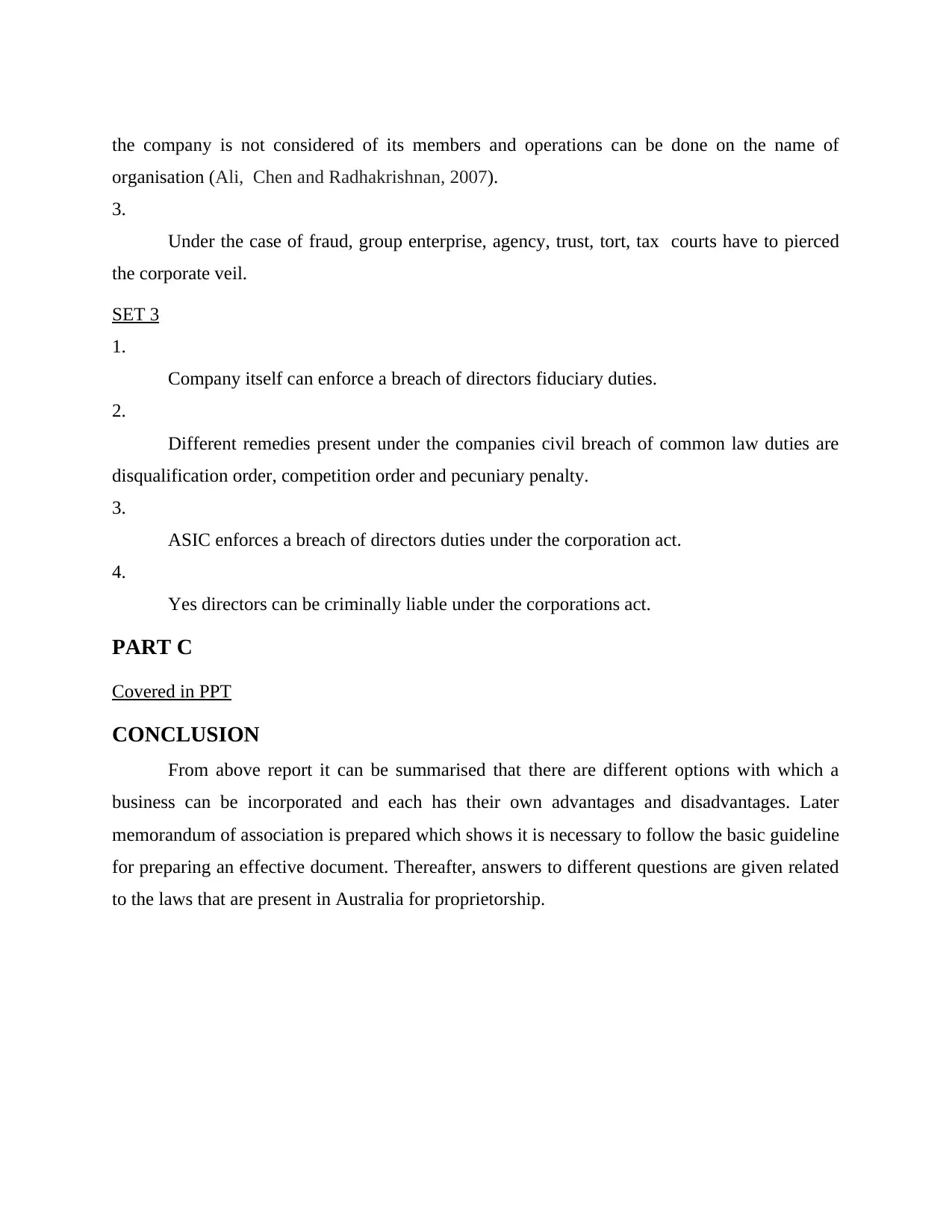
the company is not considered of its members and operations can be done on the name of
organisation (Ali, Chen and Radhakrishnan, 2007).
3.
Under the case of fraud, group enterprise, agency, trust, tort, tax courts have to pierced
the corporate veil.
SET 3
1.
Company itself can enforce a breach of directors fiduciary duties.
2.
Different remedies present under the companies civil breach of common law duties are
disqualification order, competition order and pecuniary penalty.
3.
ASIC enforces a breach of directors duties under the corporation act.
4.
Yes directors can be criminally liable under the corporations act.
PART C
Covered in PPT
CONCLUSION
From above report it can be summarised that there are different options with which a
business can be incorporated and each has their own advantages and disadvantages. Later
memorandum of association is prepared which shows it is necessary to follow the basic guideline
for preparing an effective document. Thereafter, answers to different questions are given related
to the laws that are present in Australia for proprietorship.
organisation (Ali, Chen and Radhakrishnan, 2007).
3.
Under the case of fraud, group enterprise, agency, trust, tort, tax courts have to pierced
the corporate veil.
SET 3
1.
Company itself can enforce a breach of directors fiduciary duties.
2.
Different remedies present under the companies civil breach of common law duties are
disqualification order, competition order and pecuniary penalty.
3.
ASIC enforces a breach of directors duties under the corporation act.
4.
Yes directors can be criminally liable under the corporations act.
PART C
Covered in PPT
CONCLUSION
From above report it can be summarised that there are different options with which a
business can be incorporated and each has their own advantages and disadvantages. Later
memorandum of association is prepared which shows it is necessary to follow the basic guideline
for preparing an effective document. Thereafter, answers to different questions are given related
to the laws that are present in Australia for proprietorship.
⊘ This is a preview!⊘
Do you want full access?
Subscribe today to unlock all pages.

Trusted by 1+ million students worldwide
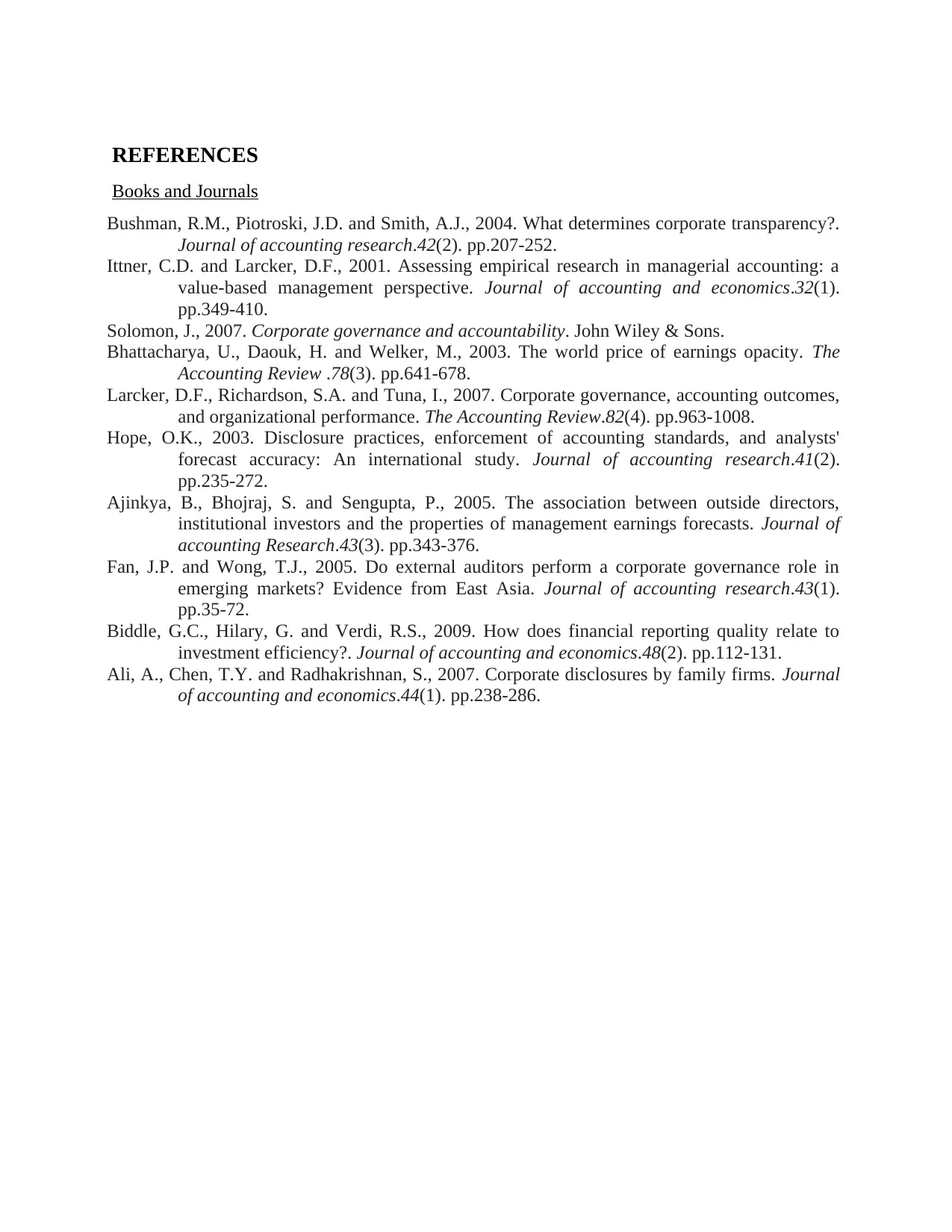
REFERENCES
Books and Journals
Bushman, R.M., Piotroski, J.D. and Smith, A.J., 2004. What determines corporate transparency?.
Journal of accounting research.42(2). pp.207-252.
Ittner, C.D. and Larcker, D.F., 2001. Assessing empirical research in managerial accounting: a
value-based management perspective. Journal of accounting and economics.32(1).
pp.349-410.
Solomon, J., 2007. Corporate governance and accountability. John Wiley & Sons.
Bhattacharya, U., Daouk, H. and Welker, M., 2003. The world price of earnings opacity. The
Accounting Review .78(3). pp.641-678.
Larcker, D.F., Richardson, S.A. and Tuna, I., 2007. Corporate governance, accounting outcomes,
and organizational performance. The Accounting Review.82(4). pp.963-1008.
Hope, O.K., 2003. Disclosure practices, enforcement of accounting standards, and analysts'
forecast accuracy: An international study. Journal of accounting research.41(2).
pp.235-272.
Ajinkya, B., Bhojraj, S. and Sengupta, P., 2005. The association between outside directors,
institutional investors and the properties of management earnings forecasts. Journal of
accounting Research.43(3). pp.343-376.
Fan, J.P. and Wong, T.J., 2005. Do external auditors perform a corporate governance role in
emerging markets? Evidence from East Asia. Journal of accounting research.43(1).
pp.35-72.
Biddle, G.C., Hilary, G. and Verdi, R.S., 2009. How does financial reporting quality relate to
investment efficiency?. Journal of accounting and economics.48(2). pp.112-131.
Ali, A., Chen, T.Y. and Radhakrishnan, S., 2007. Corporate disclosures by family firms. Journal
of accounting and economics.44(1). pp.238-286.
Books and Journals
Bushman, R.M., Piotroski, J.D. and Smith, A.J., 2004. What determines corporate transparency?.
Journal of accounting research.42(2). pp.207-252.
Ittner, C.D. and Larcker, D.F., 2001. Assessing empirical research in managerial accounting: a
value-based management perspective. Journal of accounting and economics.32(1).
pp.349-410.
Solomon, J., 2007. Corporate governance and accountability. John Wiley & Sons.
Bhattacharya, U., Daouk, H. and Welker, M., 2003. The world price of earnings opacity. The
Accounting Review .78(3). pp.641-678.
Larcker, D.F., Richardson, S.A. and Tuna, I., 2007. Corporate governance, accounting outcomes,
and organizational performance. The Accounting Review.82(4). pp.963-1008.
Hope, O.K., 2003. Disclosure practices, enforcement of accounting standards, and analysts'
forecast accuracy: An international study. Journal of accounting research.41(2).
pp.235-272.
Ajinkya, B., Bhojraj, S. and Sengupta, P., 2005. The association between outside directors,
institutional investors and the properties of management earnings forecasts. Journal of
accounting Research.43(3). pp.343-376.
Fan, J.P. and Wong, T.J., 2005. Do external auditors perform a corporate governance role in
emerging markets? Evidence from East Asia. Journal of accounting research.43(1).
pp.35-72.
Biddle, G.C., Hilary, G. and Verdi, R.S., 2009. How does financial reporting quality relate to
investment efficiency?. Journal of accounting and economics.48(2). pp.112-131.
Ali, A., Chen, T.Y. and Radhakrishnan, S., 2007. Corporate disclosures by family firms. Journal
of accounting and economics.44(1). pp.238-286.
1 out of 10
Related Documents
Your All-in-One AI-Powered Toolkit for Academic Success.
+13062052269
info@desklib.com
Available 24*7 on WhatsApp / Email
![[object Object]](/_next/static/media/star-bottom.7253800d.svg)
Unlock your academic potential
Copyright © 2020–2025 A2Z Services. All Rights Reserved. Developed and managed by ZUCOL.





